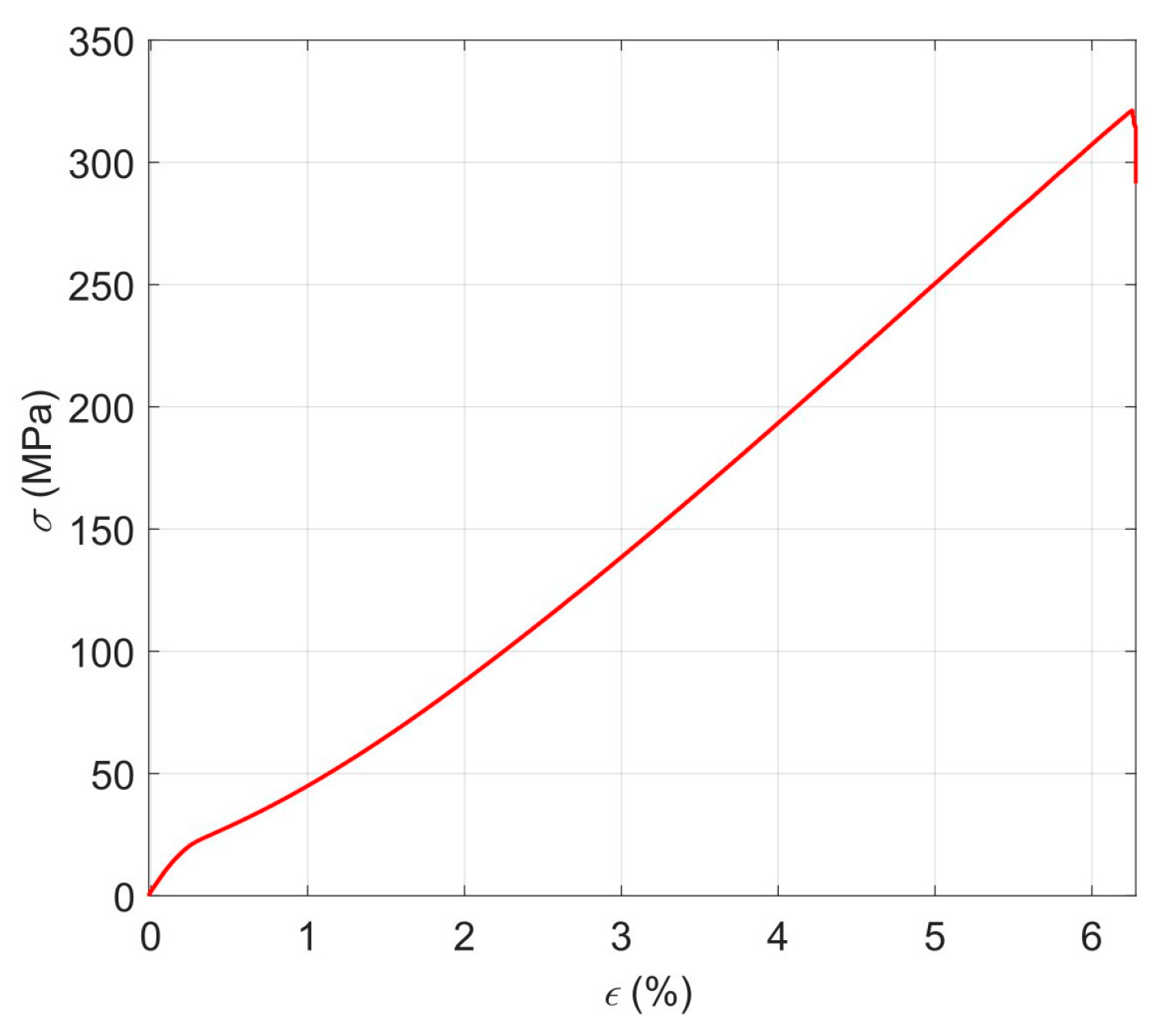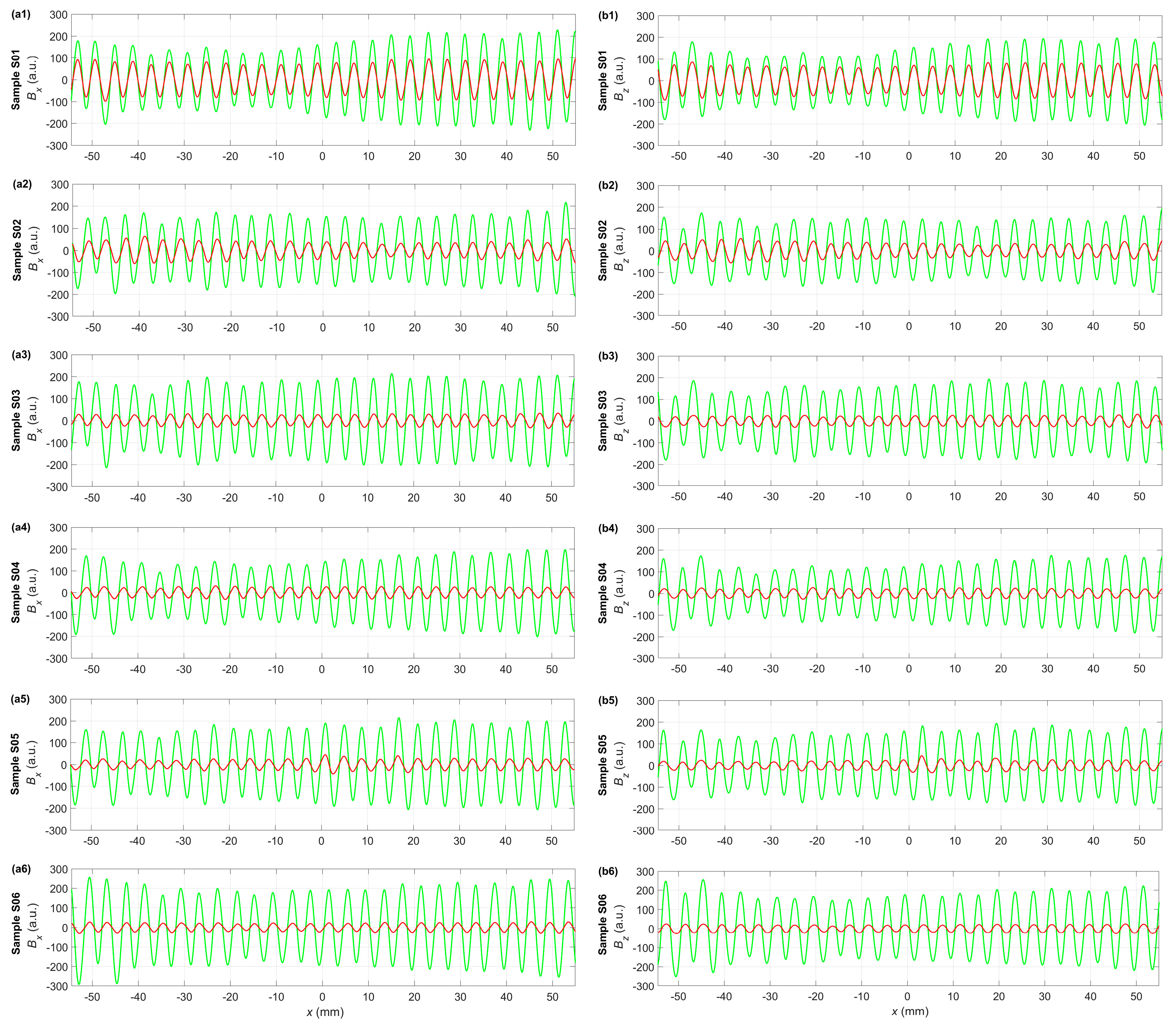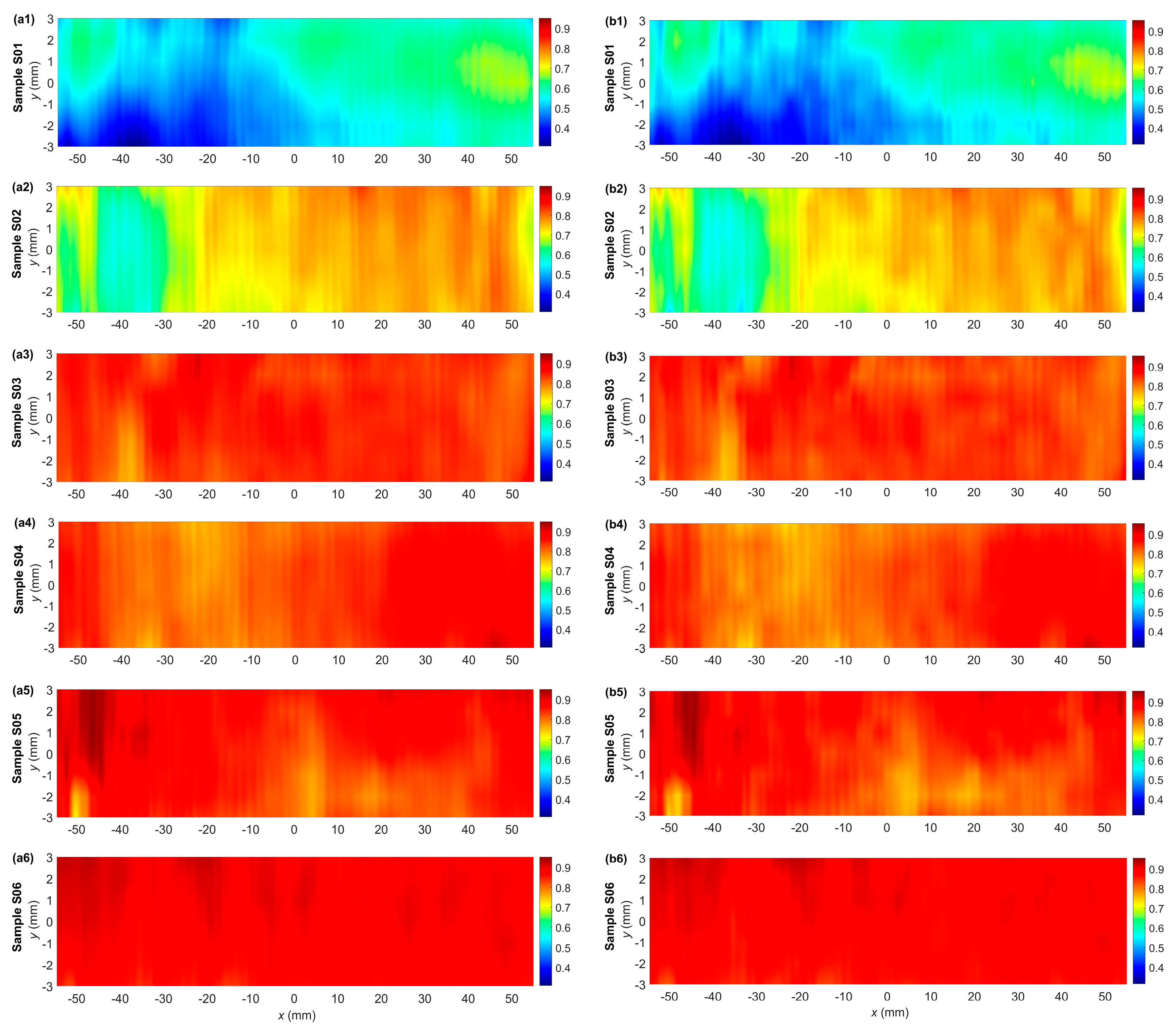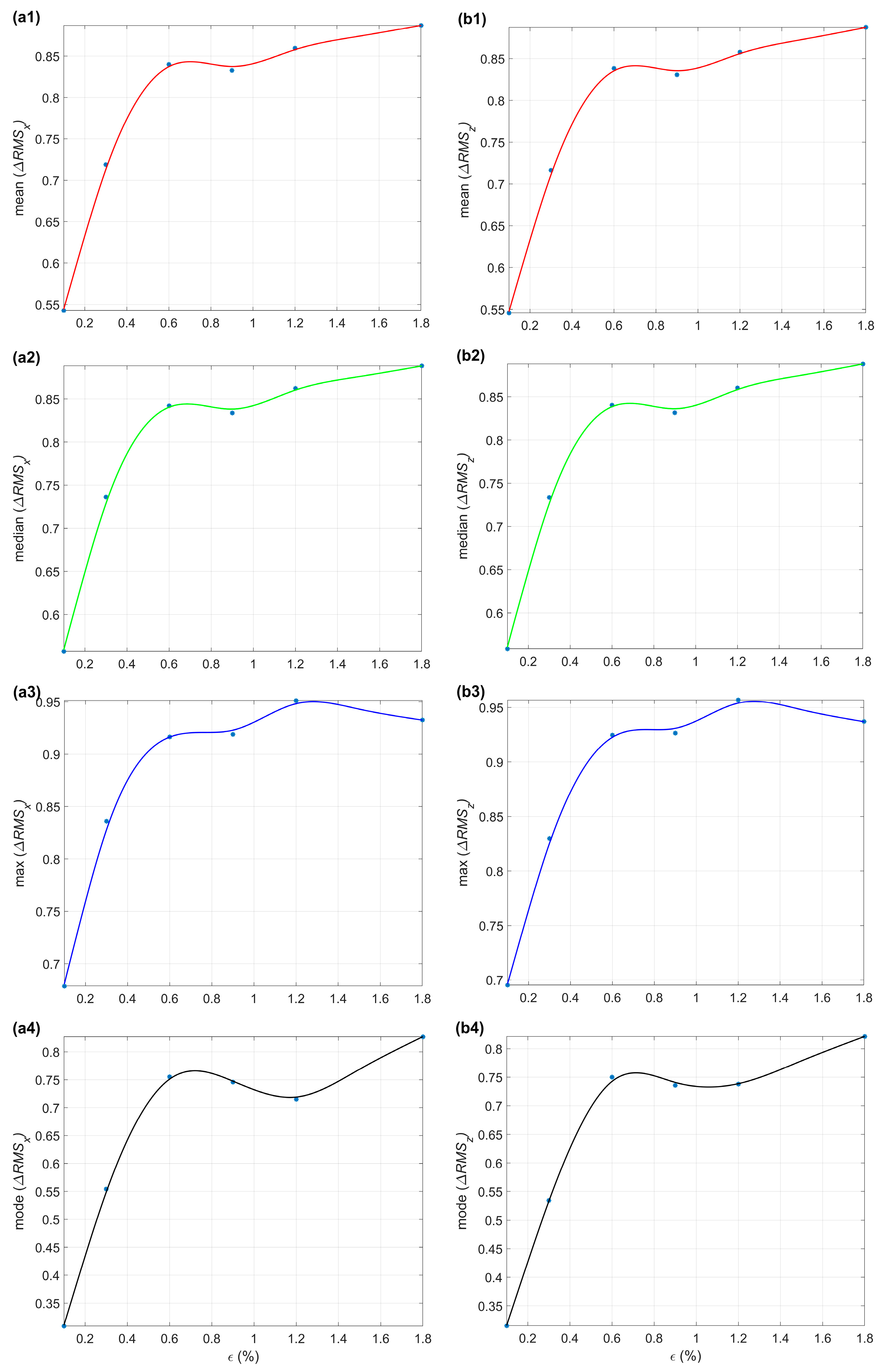Nondestructive Evaluation of Tensile Stress-loaded GFRPs Using the Magnetic Recording Method
Abstract
:1. Introduction
2. Materials
2.1. Laminates
2.2. Ferromagnetic Strips-Sensors
2.3. Adhesive for Sensors
2.4. GFRP Samples
3. Methods
3.1. Magnetization Pattern Recording and Preliminary Measurements
3.2. Quasi-Static Tensile Testing of Composite Samples
4. Results
4.1. Analysis of the Signal Obtained along the Center Line
4.2. Analysis of the Signals Measured on the Rectangular Grid
4.3. Statistical Analysis
5. Conclusions
- Using metal ferromagnetic strip sensors, the Magnetic Recording Method may be successfully employed to evaluate the load of nonmagnetic materials, such as GFRPs.
- The quasi-sinusoidal magnetization patterns recorded on the strip sensors vary their characteristic parameters with the successively strained samples. In contrast with the study results for the metal samples [20,21], only amplitude is utilizable for the unequivocal condition assessment of the GFRPs. The changes in the frequency are barely visible and thus cannot be used as a criterion.
- The calculated relative changes in the RMS value and statistical parameters enable an evaluation of the variations in the magnetization patterns caused by tensile stress. Due to the monotonicity of statistical parameters’ curves, the condition of each sample can be assessed unambiguously for the strain up to 0.6%. The precise identification of the stress level above this limit is no longer possible, especially near the yield point. The most clear-cut results can be obtained from the median value plot. This issue will be investigated in the future works.
- To sum up, the difference is that in the case of ferromagnetic structures [20,21], no additional tape is necessary because the material itself can be used as a sensor element. Concerning non-ferromagnetic structures, it is necessary to connect the sensor with a tape made of ferromagnetic material to the tested structure. This situation means that, as in the case of ferromagnetics, it is impossible to test the internal stress occurring in the material, and only the stress on the surface of the tested element is monitored. Furthermore, the use of glue or other binders may cause measurement errors, especially in the case of partial detachment. Despite these problems, the proposed method allows for the obtainment of information about the load history of the tested structure, which, in the case of other methods, requires complex measurement systems with continuous recording.
Author Contributions
Funding
Institutional Review Board Statement
Informed Consent Statement
Data Availability Statement
Conflicts of Interest
References
- Al Azzawi, W.; Herath, M.; Epaarachchi, J. Modeling, Analysis, and Testing of Viscoelastic Properties of Shape Memory Polymer Composites and a Brief Review of Their Space Engineering Applications. In Creep and Fatigue in Polymer Matrix Composites; Elsevier: Amsterdam, The Netherlands, 2019; pp. 465–495. ISBN 978-0-08-102601-4. [Google Scholar]
- Guo, Y.; Ruan, K.; Wang, G.; Gu, J. Advances and Mechanisms in Polymer Composites toward Thermal Conduction and Electromagnetic Wave Absorption. Sci. Bull. 2023, 68, 1195–1212. [Google Scholar] [CrossRef]
- Davies, P.; Choqueuse, D.; Devaux, H. Failure of Polymer Matrix Composites in Marine and Off-Shore Applications. In Failure Mechanisms in Polymer Matrix Composites; Elsevier: Amsterdam, The Netherlands, 2012; pp. 300–336. ISBN 978-1-84569-750-1. [Google Scholar]
- Hsissou, R.; Seghiri, R.; Benzekri, Z.; Hilali, M.; Rafik, M.; Elharfi, A. Polymer Composite Materials: A Comprehensive Review. Compos. Struct. 2021, 262, 113640. [Google Scholar] [CrossRef]
- Abbood, I.S.; aldeen Odaa, S.; Hasan, K.F.; Jasim, M.A. Properties evaluation of fiber reinforced polymers and their constituent materials used in structures—A review. Mater. Today Proc. 2021, 43, 1003–1008. [Google Scholar] [CrossRef]
- Chen, J.; Yu, Z.; Jin, H. Nondestructive Testing and Evaluation Techniques of Defects in Fiber-Reinforced Polymer Composites: A Review. Front. Mater. 2022, 9, 986645. [Google Scholar] [CrossRef]
- DiBenedetto, A.T. Tailoring of Interfaces in Glass Fiber Reinforced Polymer Composites: A Review. Mater. Sci. Eng. A 2001, 302, 74–82. [Google Scholar] [CrossRef]
- Karandikar, H.; Mistree, F. Integration of Information From Design and Manufacture Through Decision Support Problems. Appl. Mech. Rev. 1991, 44, S150–S159. [Google Scholar] [CrossRef]
- Saba, N.; Jawaid, M.; Sultan, M.T.H. An Overview of Mechanical and Physical Testing of Composite Materials. In Mechanical and Physical Testing of Biocomposites, Fibre-Reinforced Composites and Hybrid Composites; Elsevier: Amsterdam, The Netherlands, 2019; pp. 1–12. ISBN 978-0-08-102292-4. [Google Scholar]
- Kablov, E.N.; Startsev, V.O. Climatic Aging of Aviation Polymer Composite Materials: I. Influence of Significant Factors. Russ. Metall. Met. 2020, 2020, 364–372. [Google Scholar] [CrossRef]
- Khudhair, M.; Gucunski, N. Integrating Data from Multiple Nondestructive Evaluation Technologies Using Machine Learning Algorithms for the Enhanced Assessment of a Concrete Bridge Deck. Signals 2023, 4, 836–858. [Google Scholar] [CrossRef]
- Huang, Y.; Hung, C.-C.; Chiang, C.-H. Defect Detection by Analyzing Thermal Infrared Images Covered with Shadows with a Hybrid Approach Driven by Local and Global Intensity Fitting Energy. Eng. Proc. 2023, 55, 9. [Google Scholar] [CrossRef]
- Wang, B.; Zhong, S.; Lee, T.-L.; Fancey, K.S.; Mi, J. Nondestructive Testing and Evaluation of Composite Materials/Structures: A State-of-the-Art Review. Adv. Mech. Eng. 2020, 12, 168781402091376. [Google Scholar] [CrossRef]
- Khedmatgozar Dolati, S.S.; Malla, P.; Ortiz, J.D.; Mehrabi, A.; Nanni, A. Identifying NDT Methods for Damage Detection in Concrete Elements Reinforced or Strengthened with FRP. Eng. Struct. 2023, 287, 116155. [Google Scholar] [CrossRef]
- Malla, P.; Khedmatgozar Dolati, S.S.; Ortiz, J.D.; Mehrabi, A.B.; Nanni, A.; Dinh, K. Feasibility of Conventional Nondestructive Testing Methods in Detecting Embedded FRP Reinforcements. Appl. Sci. 2023, 13, 4399. [Google Scholar] [CrossRef]
- Talreja, R.; Phan, N. Assessment of Damage Tolerance Approaches for Composite Aircraft with Focus on Barely Visible Impact Damage. Compos. Struct. 2019, 219, 1–7. [Google Scholar] [CrossRef]
- Payo, I.; Feliu, V. Strain Gauges Based Sensor System for Measuring 3-D Deflections of Flexible Beams. Sens. Actuators Phys. 2014, 217, 81–94. [Google Scholar] [CrossRef]
- Stepanova, L.; Kabanov, S.; Matveeva, I.; Chernova, V. Strength Tests of Carbon Plastic Samples Using Dynamic Tensometry. Transp. Res. Procedia 2021, 54, 220–227. [Google Scholar] [CrossRef]
- Gräbner, D.; Dumstorff, G.; Lang, W. Simultaneous Measurement of Strain and Temperature with Two Resistive Strain Gauges Made from Different Materials. Procedia Manuf. 2018, 24, 258–263. [Google Scholar] [CrossRef]
- Chady, T.; Łukaszuk, R.D.; Gorący, K.; Żwir, M.J. Magnetic Recording Method (MRM) for Nondestructive Evaluation of Ferromagnetic Materials. Materials 2022, 15, 630. [Google Scholar] [CrossRef] [PubMed]
- Łukaszuk, R.; Żwir, M.J.; Chady, T. Examination of Ferromagnetic Materials Using Magnetic Recording Method. Int. J. Appl. Electromagn. Mech. 2023, 71, S581–S588. [Google Scholar] [CrossRef]
- PN-EN ISO 527-4; Test Conditions for Isotropic and Anisotropic Fiber-Reinforced Plastics. Polish Normalization Committee: Warsaw, Poland, 2022.
- Zeng, K.; Tian, G.; Liu, J.; Gao, B.; Liu, Y.; Liu, Q. Influence of Varying Tensile Stress on Domain Motion. Materials 2022, 15, 3399. [Google Scholar] [CrossRef] [PubMed]








| Property | Unit | Mean Value | Std. Deviation | Description |
|---|---|---|---|---|
| Rm | MPa | 254 | 12 | Tensile strength |
| Esε | GPa | 17.4 | 0.935 | Young modulus |
| νsε | - | 0.26 | 0.071 | Poisson’s ratio |
Disclaimer/Publisher’s Note: The statements, opinions and data contained in all publications are solely those of the individual author(s) and contributor(s) and not of MDPI and/or the editor(s). MDPI and/or the editor(s) disclaim responsibility for any injury to people or property resulting from any ideas, methods, instructions or products referred to in the content. |
© 2024 by the authors. Licensee MDPI, Basel, Switzerland. This article is an open access article distributed under the terms and conditions of the Creative Commons Attribution (CC BY) license (https://creativecommons.org/licenses/by/4.0/).
Share and Cite
Łukaszuk, R.D.; Chady, T.; Żwir, M.J.; Gorący, K. Nondestructive Evaluation of Tensile Stress-loaded GFRPs Using the Magnetic Recording Method. Materials 2024, 17, 262. https://doi.org/10.3390/ma17010262
Łukaszuk RD, Chady T, Żwir MJ, Gorący K. Nondestructive Evaluation of Tensile Stress-loaded GFRPs Using the Magnetic Recording Method. Materials. 2024; 17(1):262. https://doi.org/10.3390/ma17010262
Chicago/Turabian StyleŁukaszuk, Ryszard D., Tomasz Chady, Marek J. Żwir, and Krzysztof Gorący. 2024. "Nondestructive Evaluation of Tensile Stress-loaded GFRPs Using the Magnetic Recording Method" Materials 17, no. 1: 262. https://doi.org/10.3390/ma17010262






